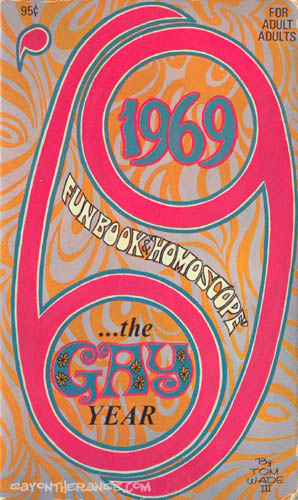
The first six covers. See all of them here, and browse scans of the mags here. Former editor Richard Neville is blogging sporadically.
A journal by artist and designer John Coulthart.

Gay on the Range (very apt name in the year of Brokeback Mountain) has a great selection of gay paperback covers from the 1950s and 60s. The one above is one of the more psychedelic examples (I was 7 years old in 1969; no one told me it was “the gay year”.) Lots of hysterical art and titles, some of them genre parodies, others delicious examples of steamy prurience that teasingly imply “exposure” of the terrible world of “the gay”. For balance, the Strange Sisters site has a similar collection of lesbian book jackets from the same period.
Elsewhere on { feuilleton }
• The gay artists archive
• The book covers archive
A number of people have asked this question, perhaps inevitably. Aside from liking the sound of the word and enjoying obscure words in general, there’s some vague justification in applying the term to an online journal. The 11th edition of the Encyclopaedia Britannica has this to say:
FEUILLETON (a diminutive of the Fr. feuillet, the leaf of a book), originally a kind of supplement attached to the political portion of French newspapers. Its inventor was Bertin the Elder, editor of Les Débuts. It was not usually printed on a separate sheet, but merely separated from the political part of the newspaper by a line, and printed in smaller type. In French newspapers it consists chiefly of non-political news and gossip, literature and art criticism, a chronicle of the fashions, and epigrams, charades and other literary trifles; and its general characteristics are lightness, grace and sparkle. The feuilleton in its French sense has never been adopted by English newspapers, though in various modern journals (in the United States especially) the sort of matter represented by it is now included. But the term itself has come into English use to indicate the instalment of a serial story printed in one part of a newspaper.

An album released on EG Records (in the UK) in 1981.
Still unavailable in its original form on CD.
The League of Gentlemen began rehearsing on March 19th in a 14th century lodge just outside Wimborne.
The personnel were:
Barry Andrews: organ
Robert Fripp: guitar
Sara Lee: bass guitar
Johnny Toobad: drums.
Our first commitment to work together covered the period March 19th to July 22nd, the second September 8th to September 24th and the third November 10th to December 4th. Johnny Toobad left on November 22nd and Kevin Wilkinson replaced him. On this album KW plays on all but Heptaparaparshinokh and Dislocated. The team played 77 gigs.
Side I
INDISCREET I
INDUCTIVE RESONANCE
MINOR MAN
HEPTAPARAPARSHINOKH
DISLOCATED
PARETO OPTIMUM I
EYE NEEDLES
INDISCREET IISide II
PARETO OPTIMUM II
COGNITIVE DISSONANCE
HG WELLS
TRAP
OCHRE
INDISCREET IIIStudio: Amy’s Shack, Parkstone, Dorset
Engineer: Tony Arnold
Photo of the League taken at Gramercy Park,
New York, during July 1980 by Marjori.
Front cover by Danielle Dax.
Cover glue Rob O’Connor.
Hamsprachtmuzic on “Minor Man” by Danielle Dax,
courtesy of the Lemon Kittens.
Extracts from the Sherborne House talks by
J.G. Bennett courtesy of Elizabeth Bennett,
available from Claymont Communications,
P0 Box 112, Charlestown, West Virginia 25414
Strategic Interaction: Paddy Spinks
Indiscretions compiled by Robert Fripp
Produced by Robert Fripp

A font by Lewis Tsalis for T.26.